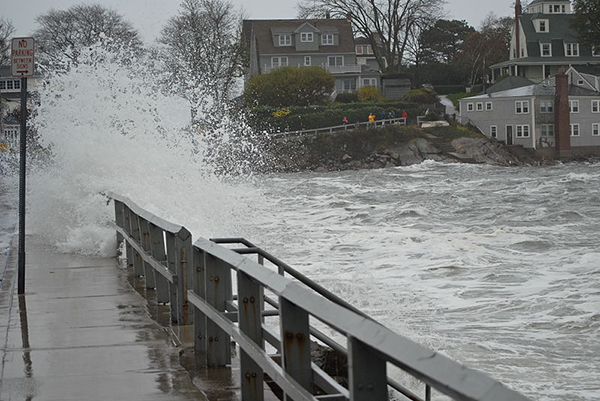
by Mary Lou Zoback Wednesday, November 7, 2012

Superstorm Sandy floods Marblehead, Mass. A new report from the National Research Council suggests ways to increase our community resiliency to hazards such as storms. The Birkes, Creative Commons Attribution-ShareAlike 2.0 Generic

The author, Mary Lou Zoback Courtesy of Mary Lou Zoback
Over the past several years, the concept of resilience has increasingly captured public attention. Even fitness clubs are advertising resilience to get you in the best shape of your life — able to handle anything that comes your way. The same resiliency that helps individuals — being mentally, physically and financially prepared, and having a disaster-recovery plan — applies to communities and even to nations.
In August, a committee of the National Resource Council (NRC) of the National Academies released a report in which the authors (myself included) looked at how communities can increase their resilience to natural disaster. The committee outlined a plan for becoming more resilient over the next two decades, but that work must begin today.
In the report, “Disaster Resilience: A National Imperative,” the NRC committee defined resilience as “the ability to prepare and plan for, absorb, recover from and more successfully adapt to adverse events.” Resilience is thus broader than preparedness, as it implies an innate ability to absorb and adapt to an array of impacts, whether anticipated or surprising.
Resiliency starts at the individual level, but the greatest impact is at the community level; to be resilient as a nation, we must be a nation of resilient communities. From a hazards perspective, a number of factors feed into resiliency. Site-specific information on risk and vulnerability to individuals and communities needs to be readily available, transparent and accessible to all. Based on this information, zoning ordinances that protect citizens and critical functions and help communities exploit natural defenses to natural hazards — such as floodplains, coastal wetlands, and sand dunes — need to be enacted and enforced. Building codes and retrofit standards need to be widely adopted and strictly enforced. If those features are in place, post-disaster recovery may be greatly accelerated by upgraded infrastructure hardened against natural disasters and with sufficient redundancy to help reduce the impact of single point failures and to address regional infrastructure interdependencies. Finally, funding for recovery needs to be available, at least partly in the form of private capital and insurance payments.
How resilient are U.S. communities now? Unfortunately we don’t know because data aren’t available. Even data that would just allow us to determine the total cost to the nation each year due to natural disasters (summed across all agencies) are not available. To gauge our current resilience, and to increase resilience in the future, the NRC recommends creating a scorecard for communities to measure their resilience level, and allow them to document improvement in their resilience over time.
A template for such a scorecard should address the two principal components of resilience: physical resilience related to the built environment, infrastructure, and natural defenses; and human resilience, which is related to governance and to socioeconomic characteristics and determinants within a community.
The NRC report suggests some specific dimensions for the scorecard:
Breaking that down further, what might such a scorecard look like in practice? Ben Billings, senior policy advisor to Sen. Mary Landrieu, D-La., suggests a very straightforward scorecard for states:
Earth scientists have a significant role to play in laying the foundation for resilience — from clarifying basic information on the physical processes responsible for natural hazards to quantifying occurrence rates and likely impacts of such events, as well as providing a better understanding of the role of natural defenses. One of the most useful capabilities of scientists and engineers in this context is to deliver site-specific hazard and risk information.
Reducing risk from an array of both natural and human-made hazards is an essential component of resilience. Natural hazards only become disasters when and where they interact with humans and our infrastructure. Often, hazard and risk are used interchangeably; however, there are specific definitions that clarify the relationship between the two. Natural hazard risk consists of three key elements: hazard (the event resulting from a natural physical process); exposure (the people and assets exposed to potential damage as a result of the hazardous event); and vulnerability (the level of sensitivity to the impacts of a natural hazard event). Hazards act on the exposure through its vulnerabilities to create risk. Effective communication of risk information for communities comes from a multidisciplinary approach involving collaboration among earth scientists, engineers, social scientists, working together with public leaders, policymakers, and journalists.
A number of factors related to hazard, exposure and vulnerability are acting to increase natural hazard risk, including that more people are living in harm’s way (particularly along coasts and in major urban centers); that the population continues to grow and age; that much public infrastructure is aging beyond acceptable design limits; that economic and social systems are increasingly interdependent; and that climate change and degradation of natural defenses such as coastal wetlands are exacerbating vulnerabilities.
Furthermore, the long recurrence time of many hazards and the short-term memory of society and policymakers impede action, as we saw with the tragic impacts of the January 2010 magnitude-7 earthquake in Haiti. Geodesists had recognized the potential for such an event near Port-au Prince based on measured strain accumulation rates, and had informed local government officials. Poverty and hunger were understandably more pressing daily issues, however, whereas dealing with long-return-period threats was a much lower priority. The challenge for scientists is to accept that society must balance many priorities and to recognize that the best solutions for reducing natural hazard risk should address multiple societal problems. Earth scientists need to be engaged and working in a multidisciplinary fashion to create and contribute to such solutions.
One such approach is to explore potential alternate designs for risk reduction. For example, in an interdisciplinary class exploring tsunami risk in Japan, Research Fellow Jenny Suckale and students from the Harvard Graduate School of Design are collaborating with researchers from the School of Engineering and Applied Science to come up with alternate designs for a tsunami or storm surge barrier. The barrier is intended for a coastal community that was totally destroyed when its former sea wall collapsed and became a collection of destructive battering rams during the 2011 tsunami.
Because it made the tsunami destruction worse, the community was loath to replace the old sea wall. However, in their project, the student team is evaluating whether an novel, alternative double wall design, with an outer porous wall, might address multiple issues: creating constructive interference through the spacing of the two walls to help attenuate some of the incoming wave energy; using the area between the walls as fertile oyster beds to foster a new source of income for the community; and creating a new barrier that looks and functions completely differently than the old dreaded barrier — hence adding to its acceptability within the community.
Ample opportunities exist for earth scientists interested in reducing natural hazard risk and increasing resilience to get involved through both basic and applied research. Many of the steps described above need to occur at the local level with earth scientists engaged from the beginning.
© 2008-2021. All rights reserved. Any copying, redistribution or retransmission of any of the contents of this service without the expressed written permission of the American Geosciences Institute is expressly prohibited. Click here for all copyright requests.